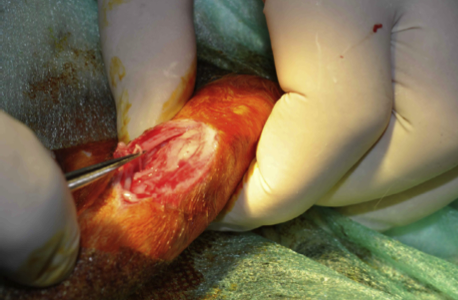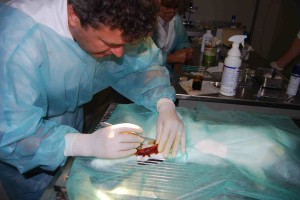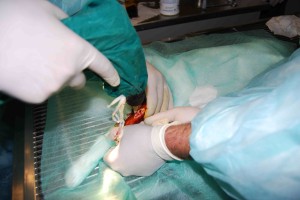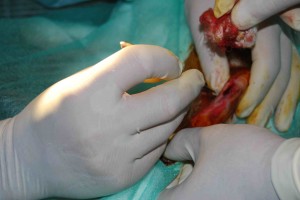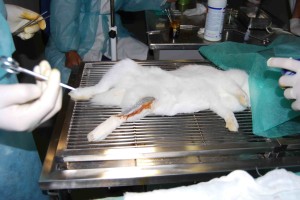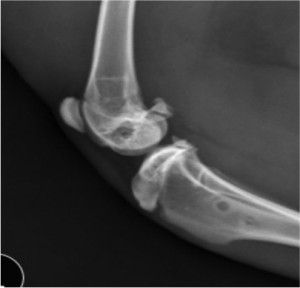Project Title: Evaluation of an original alternative for treating osteomyelitis using an animal model
This work is supported by a grant of the Romanian National Authority for Scientific Research CNCS – UEFISCDI under contract Number 322/2011.
Research team: Dr. Cristina Surdu-Bob – project director; Team members and collaborators: Dr. Coman Cristin, Dr. Ene Vlase, Dr. Florica Barbuceanu, Dr. Andrei Popovici, Prof. Dr. Danut Turcu, Dr. Marius Badulescu, Dr. Mariana Oporanu, Dr. Mariana Coman, Chem. Elena Raiciu.
Introduction
Osteomyelitis is an inflammation of bone or medullary cavity due to infection. The cause of infection is a bacteria or fungi. The most common bacteria that causes osteomyelitis is Staphylococcus aureus, but other bacteria were also found responsible for this illness: Staphylococcus epidermidis, Streptococci, E. coli, Proteus. No important progress in curing the disease with less invasion into the body was achieved up to now. Current treatment of osteomyelitis includes high dose antibiotics (like Nafcillin, Ceftriaxone, Cefazolin, Ciprofloxacin, Ceftazidime, Clindamycin, Vancomycin, Linezolid) for 6 weeks to 6 months, pain medications and surgery. Treatment for a staph infection is difficult, as bacteria are resistant to many antibiotics, as in the case of MRSA (Methicillin Resistant Staphylococcus Aureus) and VRSA (Vaconcomicine Resistant).
The current project proposes to use engineered implants.
The first part of the project is concerned with finding a reliable animal model for both acute and chronic osteomyelitis and the second part is dedicated to the efficacy of the therapy concept proposed.
The in vivo experiments were undertaken under national and international regulations concerning animal testing, using a protocol approved by the ethics committee of the National Institute for Microbiology and Immunology “Cantacuzino” – Bucharest.
Synthetic Report
2011
During the two months available from the start of the project, the team made a thorough investigation of current literature and elaborated a general research strategy and also a detailed protocol for the first experiments to be undertaken in 2012. The following conclusions were drawn:
In order to assess the efficacy and toxicity of proposed treatment, an animal model of inducing osteomyelitis (both forms: acute and chronic) had to be established. The animal specie, bacterial type and route of inoculation were chosen based on current literature results showing good outcomes in terms of reproducibility and survival rate. Thus, a rabbit tibial model involving Staphyloccocus Aureus (SA), ATCC 6538 was chosen.
Regarding animal monitoring, the following methods were chosen: daily clinical observation and radiological, microbiological and histological investigations. In terms of clinical evaluation, the presence of fever, lethargy, weight gain, food intake, general and local clinical signs, hematological monitoring were envisaged. Radiological monitoring consists on observing the severity of a lesion using a scoring system proposed in current literature. Histological evaluation will be undertaken on bone samples taken from the bacterial inoculation site. Microbiological investigations were also planned to be undertaken in order to assess the presence and type of bacteria that developed during the experiment.
2012
Scope: Induction of osteomyelitis and preliminary studies of treatment outcome. A series of experimental models of osteomyelitis on rabbits using foreign bodies as infection promoters were involved in order to find a reproducible animal model of osteomyelitis with low mortality.
Materials and methods
Animals: 40 New Zealand rabbits of approx. 2.7 Kg weight were involved in the study.
Bacterial strain: ATCC 6538 Staphylococcus aureus, 5×107 UFC/ml
Materials used for induction of disease: steel balls, Kirschner wires, cotton meshes
Animal monitoring
The experiment was run for 60 days and the health state was monitored by general and local clinical examination and hematological, radiological, microbiological and histological investigations at regular time intervals.
Hematological tests of blood taken in EDTA microcontainers were performed in all animals, on day 23, 43 and 50 after inoculation, using a Pro CYTE IDDEX instrument. Blood counts monitored: RBC, PCV, hemoglobin, MCV, MCH, MCHC, RDW, RETIC%, RETIC, WBC, Neutrophils, Lymphocytes, Monocyte, Eosinophil, Basophils, Blood platelets, MPV and PDW. The data obtained were compared to normal values taken from Suckow M, Douglas F, The Laboratory rabbit, CRC Press, 1997. Microbiological examination involved biochemical and immunological assays of biopsies of the hematogenous bone marrow from the inoculation site.
Results:
Osteomyelitis was reproduced in all four models used, the survival rate being between 70 and 90%. It was observed that installation of acute and chronic disease differed from one group of rabbits to the other. The cotton mesh model was the most reproducible animal model and it was further used in treatment experiments. Detailed results can be found in the paper: The influence of foreign body surface area on the outcome of chronic osteomyelitis, published in Medical Engineering and Physics, vol. 38, pag. 870-876 (2016).
Regarding treatment, the preliminary experiment has put in evidence that no adverse effects are induced by the particles, in healthy rabbits.
2013
Scope: The data resulted from the preliminary animal model undertaken in 2012 were analyzed. Conclusions regarding best set-up and procedures for optimal outcome were drawn. Next, in a new animal model, the therapeutic potential of our proposed treatment (Treatment type 1) was studied by microbiological, radiological and histological investigations. The treatment targeted the acute and chronic disease and also its preventive potential against osteomyelitis.
An in vitro study was also designed for the assessment of efficacy of treatment particles against Staphylococcus aureus ATCC 6538 bacteria. A lysis zone was formed around the treatment particles, this clearly showing their antibacterial effect.
Materials and Methods:
Animals: 73 New Zealand rabbits of approx. 2.3 Kg weight were involved in the study.
Bacterial strain: ATCC 6538 Staphylococcus aureus, 5×106 UFC/ml
Materials used for treatment: engineered particles, treatment type 1
Results:
The results suggest that the particles of Treatment type 1 prevented the development of infection and induced reparatory processes in infected tibia of rabbits. Conclusions over the best site of inoculation of treatment particles were drawn.
2014
Scope: The results of the animal experiment undertaken in the previous year were analyzed and correlations regarding treatment outcome in terms of mortality rate, severity of lesions in the chronic and acute forms were made. Results of the prevention treatment were also analyzed. Synthesis of particles for the type 2 treatment.
Results:
Hematological results have shown that no significant differences between treated and untreated groups were developed. In contrast, the radiological results have shown clear modifications of the rabbit tibia, with higher intensity in the non-treated group. The main lesions observed were: periosteal deformation and bone architecture deformation. Histological results confirmed the radiological data: reparatory processes at the level of cortex and medulla, presence of conjunctive tissue, neoformation tissue and osteoblasts.
Bone neoformation, presence of osteoblasts and conjunctive tissue were observed in the tibia of treated rabbits. Control rabbits developed chronic osteomyelitis. This result gains an even higher importance knowing that it was obtained under severe infection of the bone consisting of a foreign body kept in place during treatment. Signs of toxicity expressed by inflammatory reactions were observed only after 60 days of contact with particles, in vivo.
We could conclude that the treatment type 1 applied preventively, simultaneously given with the microbial solution, induced a slow evolution of the disease with low severity lesions. The treatment applied on the acute and also on the chronic form of osteomyelitis induced reparatory processes at the inoculation level.
Particles to be used for the treatment type 2 were synthesized, also. A new protocol for the next experiment was designed.
2015
Scope: The treatment type 2 was tested both in vitro and in vivo.
Materials & Methods
Animals: 20 New Zealand rabbits of approx. 2.9 Kg weight were involved in the study.
Bacterial strain: ATCC 6538 Staphylococcus aureus, 5×106 UFC/ml
Materials used for treatment: engineered particles, treatment type 2
Results:
While the untreated group of rabbits developed progressive bone architecture deformations, periosteal lesions and necrosis, the treated rabbits presented a mild but clear improvement in time of the initially installed lesions. Regarding toxicity, inflammatory reactions were mainly observed in the group where the meshes were kept in place for the whole duration of treatment.
The main finding was that necrosis was absent in both treated groups: preventive (5 out of 5 rabbits) and treatment on the acute phase (8 out of 10 rabbits) while the untreated rabbits presented necrosis (4 out of 5).
Aiming at finding other means of non-invasive assessment of inflammation and necrosis, we collaborated to develop new sensors to analyze blood samples. The success registered with these sensors will hopefully allow better diagnosis of acute and chronic forms of osteomyelitis.
2016
Scope: Evaluation of treatment type 2 against the chronic form of osteomyelitis and also evaluation of toxicity of the treatment.
Materials & Methods
Animals: New Zealand rabbits
Bacterial strain: ATCC 6538 Staphylococcus aureus, 5×106 UFC/ml
Materials used for treatment: engineered particles, treatment type 2
Results:
Continuous evolution of tibial infection and progression of ostemyelitis was observed in the non-treated rabbits group. In contrast, an atenuation of signs of chronic osteomyelitis was observed by radiology in treated rabbits. Micro-tomography was extremely valuable in providing high resolution images of structural changes of the bone. This allowed finer observation of changes in lesions. One of the three rabbits evaluated by microtomography was found healed of chronic osteomyelitis.
Note: Submission and reviewing of our papers is in progress. Further information will be posted as soon as available
Published papers:
- Surdu-Bob Cristina Carmen, Coman Cristin, Barbuceanu Florica,Turcu Danut, Bercaru Nicolae, Badulescu Marius, The influence of foreign body surface area on the outcome of chronic osteomyelitis”, Medical Engineering and Physics, vol. 38, pag. 870-876 (2016).
- Stefan-van Staden, RI, Comnea-Stancu, IR, CC Surdu-Bob, M. Badulescu, Nanostructured materials detect epidermal growth factor receptor, neuron specific enolase and carcinoembryonic antigen, Nanoscale, Vol.7, Is.38, 2015.
- Raluca-Ioana Stefan-van Staden, Ionela Raluca Comnea-Stancu, Carmen Cristina Surdu-Bob, Camelia Stanciu-Gavan, Pattern recognition of neuron specific enolase and carcinoembryonic antigen in whole blood samples, Journal of Molecular Recognition, Journal of Molecular Recognition, vol.28, no.2, 2015
- Cristina Surdu-Bob, Danut Turcu, Marius Badulescu, Cristin Coman, Comparative study of antibacterial activity of solid materials using an antibiogram assay, E-MRS Proceedings 2015.
- Cristin Coman, Cristina Surdu-Bob, Marius Badulescu, Gonciarov Magda, Radiological assessment of experimental model of human osteomyelitis in rabbits, Agriculture and Agricultural Science Procedia, vol. 6, pag. 299 – 304 (2015).
- Cristina Surdu-Bob, Cristin Coman, IonTiseanu, Danut Turcu, Ene Vlase, Marius Badulescu, Gonciarov Magda, Selective Bacterial Invasion of Bone – Evidence of Inter-Bacterial Communication, Journal of Biotechnology 2015, Volume 8, Page 208
- Raluca-Ioana Stefan-van Staden, Iuliana Moldoveanu, Carmen Cristina Surdu-Bob, Camelia Stanciu-Gavan, Engineered nanoporous gold microspheres for stochastic sensing, RSC Advances 2014, vol. 4, Page 54140
- Cristina Surdu-Bob, Cristin Coman, Ene Vlase, Florica Barbuceanu, Andrei Popoviciu, Danut Turcu, Marius Badulescu, Local treatment of induced chronic osteomyelitis in rabbit tibia – A comparative study, Journal of Biotechnology, Volume 185, Supplement, September 2014, Page S96, ISSN 0168-1656
- Cristina Surdu-Bob, Cristin Coman, Florica Barbuceanu, Ene Vlase, Andrei Popoviciu, Danut Turcu, Marius Badulescu, Preventive treatment implant particles against osteomyelitis – An animal model, Journal of Biotechnology, Volume 185, Supplement, , Page S94, ISSN 0168-1656, 2014
- C. Coman, C. C. Surdu-Bob, D. Turcu, E. Vlase, Mariana Oporanu, M. Bădulescu, “Evaluarea clinica si microbiologica a unui model experimental de osteomielita umana”, Revista romana de medicina veterinara, Vol.23 issue 2 pag 65, 2013.
- C Coman, C Surdu-Bob, F Barbuceanu, D Turcu, A Popovici, E Vlase, M Oporanu, M Badulescu, “Refining an experimental model of osteomyelitis in rabbits”, Journal of the American Association for Laboratory Animal Science Vol 52, No 3, May 2013, 266
Photo Gallery:
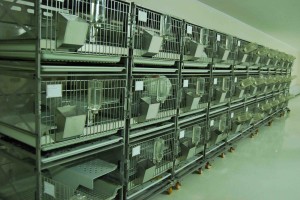 Figure 1: The rabbits used in the experiment
Figure 1: The rabbits used in the experiment
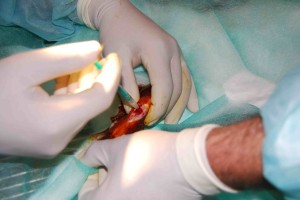 Figure 5: Inoculation of pathogen
Figure 5: Inoculation of pathogen
